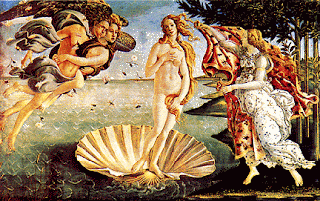
Then it came the development of ideogram/ideograph which is the term itself common used to describe logographic language systems such as Egyptian hieroglyphs and Chinese charaters. However, symbols in logographic system generally represent words or morphemes rather than pure ideas. On the other hand, nowadays, an ideogram or ideograph is a graphical symbol that represents an idea, rather than a group of letters arranged according to the phonemes of a spoken language, as is done in alphabetic languages. Examples of ideograms include wayfinding signage, such as in airports and other environments where many people may not be familiar with the language of the place they are in, as well as Arabic numerals and mathematical notation, which are used worldwide regardless of how they are pronounced in different languages
Followed by the invention of language and number, other apllications also invented with the purpose of visual communication such as books, illuminated manuscrips, photography and film. Under influence of historic changes, for example the Renaissance, Industrial revolution, the collapse of Soviet Union, visual communication from time to time has been witnessed some revolutions it self, and some of them are really enriches the human knowledge by some art master pieces from great artists : Salvatore Dali, Michael Angelo, Van Gogh, Warhol...
 Here below is the Timeline of art which I accidentally ran into while googling about Visual Communication. In my opinion, this table really gave me a clear vision of the history of art and visual communcation regarding some of the most importance events at that time.
Here below is the Timeline of art which I accidentally ran into while googling about Visual Communication. In my opinion, this table really gave me a clear vision of the history of art and visual communcation regarding some of the most importance events at that time.
Timeline of Art
| Era | Artist | Style | Media | World |
| B.C. | | | | |
| 15,000 | Ancient | Charcoal | | |
| 5000 | | Ancient | Pictographic writing | Civilizations of: |
| 1000 | Dipylon vase | Papyrus | | |
| 400 | Acropolis | |
| |
| 200 | Nike of | | ||
| 100 | | | ||
| A.D. | | | | |
| 400 | | | ||
| 600 | | Papermaking introduced from | Charlemagne | |
| 1000 | | | ||
| 1250 |
| Magna Carta | ||
| 1400 |
| |||
| 1500 | Michelangelo | High Renaissance | First use of canvas |
|
| 1600 | Galileo | |||
| 1700 | Boucher | | Steam engine invented | |
| 1750 | Fragonard | | American Revolution | |
| 1800 | Goya | Photography | Louisiana Purchase | |
| 1850 | Tube paints |
| ||
| 1875 | Colonialism peaks | |||
| 1900 | Airplane invented | |||
| 1950 | | Vietnam War | ||
| 2000 | | | | |


Geen opmerkingen:
Een reactie posten